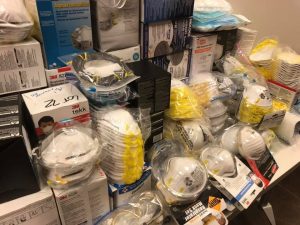Governor Walz: Expect Mandate on Masks, Raises Concern About PPE Shortages
Minnesota Governor Tim Walz provided an update on his administration’s ‘battle plan’ to help long-term-care facilities, but also expressed growing concern that the state could grow short again on testing and PPE supplies. He also hinted that Minnesota would join 28 other states in enacting a mask mandate.
“I think you can expect an announcement in the next day or two,” said Walz about the mask mandate.
 How COVID-19 is impacting our community
How COVID-19 is impacting our community
Find all of our latest COVID-19 stories here
Long-Term Care Facility ‘Battle Plan’ Update: “We’ve made progress, but there’s still more work to do”

First St. Therese resident tested positive for coronavirus April 5
Long-term-care (LTC) facilities, which includes nursing homes and assisted living, were hit hard at the start of COVID-19 pandemic. Most of the deaths early on in Minnesota occurred at these facilities. They included death tolls that grew past 50 at St. Therese of New Hope and more than 40 at North Ridge Health and Rehab in New Hope.
“This idea that there was something that these facilities did wrong in the early part of COVID is simply not the case,” said Walz. “It was very challenging.”
About 77% of COVID-19 deaths have occurred at long-term care facilities up to this point. State health officials say facilities struggled early on to get PPE to nursing facility workers, some of whom had become infected with the virus, but did not have symptoms, unknowingly spreading the virus to patients. Deaths and cases have since been curtailed. Between May 17 to May 23, there were 137 deaths linked to COVID-19 at long-term care facilities. From July 12-17, there were 13 deaths.
“We’ve made progress, but there’s still more work to do,” said Governor Walz.

N95 masks collected from a recent community drive. Courtesy: MN Nurses Association
The Walz Administration provided an update to its ‘battle plan’ that went into effect in May. Health officials touted progress on the following five key points:
- Expand testing for residents and workers in long-term care facilities. All facilities with at least one case implemented widespread testing of residents and staff. The Minnesota National Guard assisted in this effort.
- Provide testing support and troubleshooting to clear barriers faster. This included the launch of a nurse triage hotline for COVID-19 information that provided a single toll-free number for all major Minnesota healthcare systems.
- Develop a system for prioritizing and disbursing PPE to facilities. Health officials noted that the state never had a stockpile of PPE until COVID-19.
- Ensure adequate staffing levels for even the hardest-hit facilities. State developed a scheduling software system that identified staffing shortages at facilities to help fill shifts. Health officials say more than 1,100 qualified healthcare professionals signed up in volunteer database. In June, state said 36% of available shifts were filled through this system.
- Leverage partnerships at all levels. These partnerships included state and federal agencies, as well as long-term care associations and regional healthcare coalitions to improve long-term care testing, staffing, PPE distribution, and patient surge capacity and discharge.
Minnesota Department of Health Commissioner Jan Malcolm said her agency provided assistance to more than 930 LTC facilities to reduce infection. Her department also did on-site visits to more than 245 facilities.
“These facilities are safer today than at the beginning of the pandemic,” said Malcolm.
MDH officials say facilities that have had both large and small outbreaks have successfully stopped the spread of the virus.
Of the total 1,165 facilities with an outbreak, 714 or 61% have had one or two cases to date. Of these, 538 or 75% have had no COVID-19 cases for 28 days. As for the 95 facilities with larger outbreaks of 20 or more cases, 51, or 54% percent have been free of COVID-19 cases for 28 days, MDH officials said.
Addressing Masks and Schools
Walz said the push to wear masks isn’t just an administration mandate.
“Businesses tell us we do,” said the governor, noting all the retailers that now require masks to enter stores.
“If we can get 90 to 95 percent mask compliance over the next four to five weeks, we think the statistical numbers will make it so we can maintain and continue to open.” he said.
A decision on providing guidance to schools by the Walz Administration is expected by July 27.
Walz said, “The simplest thing we can do to get back in school, the simplest thing we can do to open up and make sure our businesses remain like they are, the simplest thing that Republicans can do to make sure I don’t have to take executive actions around the pandemic, is to wear a mask.”


